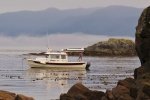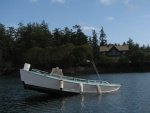Like Harvey, I am very leery of both a bow and stern tie. I've done it to be sure, but as Harvey says, it can only be done in low current areas.
Even too much wind can cause problems. I was once on a sailboat anchored in an area with modest currents. In the late evening the current changed and a strong wind developed from the same direction as the current....both abeam the boat. Earlier in the day we had set bow & stern anchors to minimize rolling during dinner. The boat became pinned between the 2 anchor points......so much so that we were afraid to loosen the line off either cleat. In the end, we simply prussicked a fender to the stern anchor line, and then cut the anchor line since it was cheap and cleated near the bitter end, so we didn't lose much line. The boat swung neatly into position. The next morning we easily retrieved the bow anchor with the windlass, and then went to retrieve the abandoned lunch hook.
P.S. There is one situation where I often tie off to the stern. Again in an area of modest current/wind, and after I am firmly anchored with the bow anchor. This is usually in the late afternoon. As the boat swings with the current/wind, or because of sun movement, we sometimes lose the sun in the cockpit . So I go to the bow and quickly release about 30' of anchor line without touching how the anchor line is cleated (must be held outside of the pulpit etc). I then walk the line back to the cockpit, keeping it outside of everything, and tie it off to a stern cleat. In a few minutes the boat usually swings 180° and viola we have sun again (you can even vary the angle somewhat by which stern cleat you use). Once the sun sets, I simply release the anchor line from the stern cleat, and the boat comes back to its bow pivot point.


